#Disney Film Era Polls
Text
I'm ONLY counting the films from the Walt Disney Animation Studios line-up between 1967 (after The Jungle Book) and 1989 (before The Little Mermaid). There's some debate on what this era of Disney animation is called, so I went with both titles I tend to hear a lot. I feel like this poll requires a fairly niche audience since a lot of these are (sadly) forgotten.
#Starling polls#Disney Film Era Polls#Disney#Disney Bronze Age#The Aristocats#Robin Hood#The Many Adventures of Winnie the Pooh#The Rescuers#The Fox and the Hound#The Black Cauldron#The Great Mouse Detective#Oliver and Company#original post#1k+ votes#100 notes#500 notes#1k notes
1K notes
·
View notes
Text

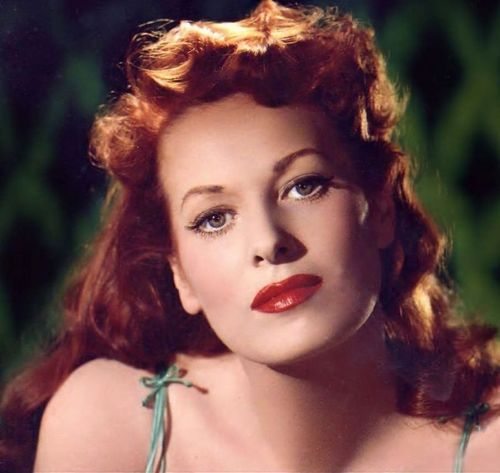
Propaganda
Eva Dahlbeck (Smiles of a Summer Night, A Lesson in Love, Kastrullresan)— Beautiful, formidable, funny. Ingmar Bergman called her a "battleship of femininity" and cast her in several of his comedies. It's a joy to see her pulling all the strings in Smiles of a Summer Night while her two boyfriends make utter fools of themselves.
Maureen O’Hara (The Parent Trap, The Quiet Man)—They called her the Queen of Technicolor. That right there should help introduce people to the fiery, wonderful, stunning Maureen O’Hara. She was from Ireland, born in 1920, and started in theater at the age of ten. At 15, she was winning drama awards, including one for her performance as Portia in the Merchant of Venice. At 16, she was the youngest pupil to graduate from the Guildhall School of Music. By 18, she transitioned to film, starting off with a bang alongside Charles Laughton in Hitchcock’s Jamaica Inn, and proceeded to work steadily up through the early 1970s. She was in adventures and comedies and romances, spent a lot of time in westerns giving merry hell to John Wayne (and less merry hell to the indomitable John Ford — she held her own even when he was verbally abusive and demeaning to her). She was in The Quiet Man, which was the first American-made film entirely filmed in a foreign country. She helped make American Christmas what it is with Miracle on 34th Street. She played a lineup of headstrong, forthright women second only, perhaps, to Katharine Hepburn. She was married three times, lived for a while with a boyfriend in Mexico, sued for custody of her daughter in the 1950s, AND sued a magazine for libel in the same era. After mostly retiring from acting, she edited a magazine. She eventually sold the magazine to spend more time with her grandson, but even then ran a ladies fashion store. She was an outspoken, brilliant, passionate lady, with amazing red hair, a career to envy, and — well — that face!
This is round 1 of the tournament. All other polls in this bracket can be found here. Please reblog with further support of your beloved hot sexy vintage woman.
[additional propaganda submitted under the cut]
Eva Dahlbeck:

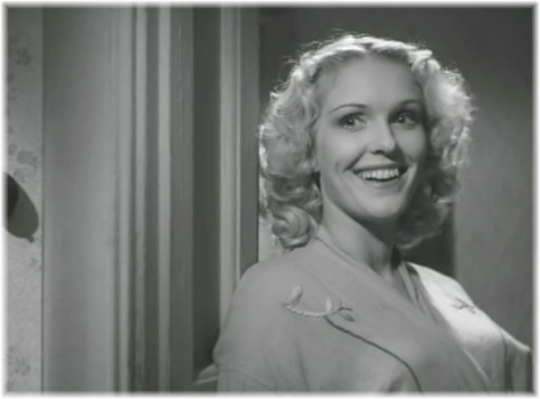
Maureen O'Hara:

I thought she was one of the most beautiful women in the world when I was a kid and I have yet to really change my mind. Always loved her temper and her red hair. Plus she was kind of a MILF in The Parent Trap
Haughty, red hair, hot.
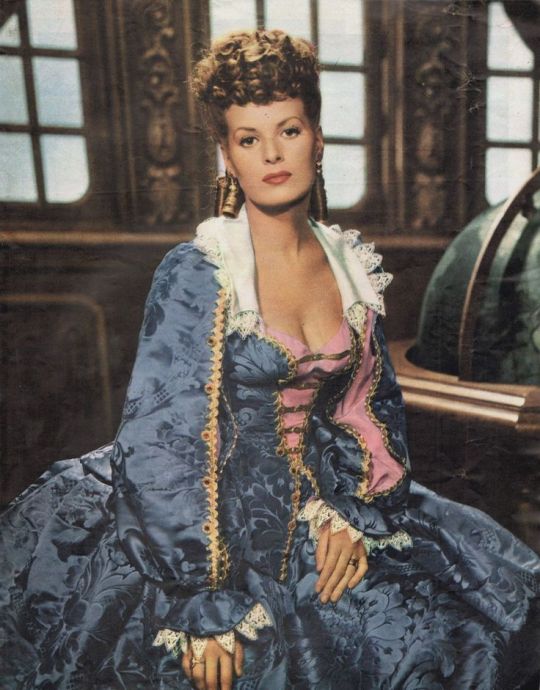
The hair. The accent. The figure. The acting chops. The perfection.


I would have to give up my passport if I didn't submit Maureen O'Hara but also have you seen her? Not only did she look like that (she was called the Queen of Technicolor, though she wasn't a big fan of that sobriquet), she was also very funny and tough as nails. She faced off against Walt Disney in a contract dispute and the legend goes that when someone mentioned her at his deathbed, he sat up and said 'That bitch!'. Her comment on that story is "At least he didn't think of me and say, 'That wimp'." She struggled to get serious roles for a time, saying ""Hollywood would never allow my talent to triumph over my face," so she plays the sexy princess/pirate/harem girl in a LOT of early movies that she referred to as "Tits and Sand" films, she being the tits in question. She also turned down so many leading men and studio bosses (Errol Flynn and Howard Hughes are among her rejects) that there were rumours spread that she was a lesbian. Many egos were battered it seems. I'm including the infamous Lady Godiva scene in the photo propaganda for the sheer Moment of it [link] . It was a bit of a flop critically, but it was one of Clint Eastwood's first film appearances and she said he told her later that he was very glad of the money at the time. She was a very proud Irish woman and when she went for her American citizenship they insisted on referring to her as British (the timeline of Irish independence is a bit wibbly wobbly, we won't get into it here). She refused to accept American citizenship under that condition and argued her way through every level of US immigration she could find, supposedly saying "I'm not responsible for your antiquated records here in Washington", until a judge finally gave up and said "Give her what she wants, just get her out of here". This made her the first ever person seeking US citizenship to be proclaimed Irish on the record! And while we don't embrace the leprechaun imagery quite so enthusiastically today, her dressing her dog up in a little shamrock hat is too cute for you all to miss so I'm including that in the photo propaganda.
*Marge Simpson voice*: I just think she's neat 🤷♀️
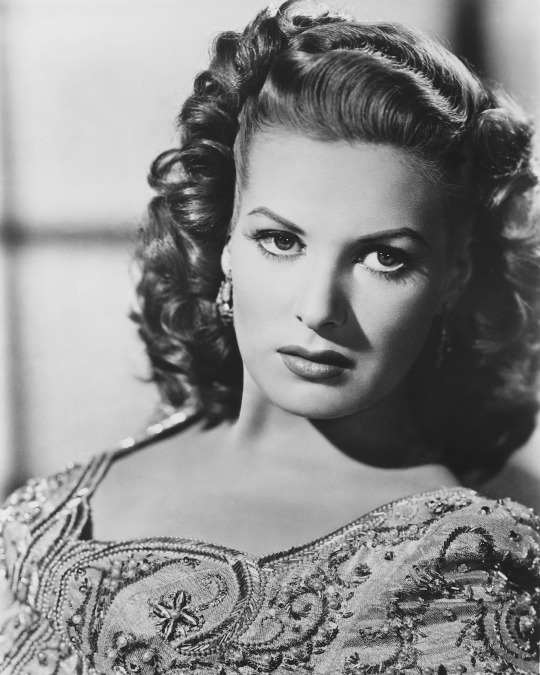
106 notes
·
View notes
Note
Home on the range!! Im surprised to see it in a poll, i often feel im the only one i know who is aware of the evil yodeling hypnosis villain. Do you have any thoughts you wish to share about that movie? I find it quite fun!!
This will maybe be the most controversial opinion to come out of the mid-sney poll, but (aside from the film which I personally voted for. Great Mouse Detective Sweep, etc.) I think Home On The Range is the best of the films listed.
I love that it has three female leads with no romance subplot. I love the character designs on all three leads and the immediate interplay between the personalities. I love that it comes from an era where Disney could still make *comedy* animation, even if it missed the mark in a lot of ways.
Disney in the mid-2000s wasn't the "feel-good nostalgia" company yet, they hadn't hit their stride and so were still willing to experiment with different kinds of stories in the new millennium.
And it's not even a true departure. I think the yodeling cow-rustling sequence hearkens back to the "Pink Elephants On Parade" days in a deliberate way! Stuff like that just doesn't happen in Disney movies anymore except in very controlled story moments, because it's weird. But we like it *because* it's weird!

(My senior animation film also was a silly story with an action sequence set in a fantastical wild-west, so I might be somewhat impartial here.)
Disney likes to remind us that animation can be beautiful and breathtaking. It can enhance the things about reality that are wonderful and make the real feel hyper-real. But it can also completely bend reality to be fun and silly and *un*-real, and those kinds of movies can and should exist too! Home On The Range might be ridiculous and over-the-top, but I like it because it reminds me of the days when that was still something Disney might do. They leave this kind of thing to Illumination and DreamWorks now.
My feelings aside though, I'd love to see Home On The Range get a retroactive fandom on tumblr where people ship the cows together. Maggie could be a butch lesbian icon! I'm just saying.

Thanks for the ask!
24 notes
·
View notes
Text
I already know going in that the Disney Renaissance will most likely dominate in this poll, but I am curious to see what the runner up will be by the end.
14 notes
·
View notes
Text
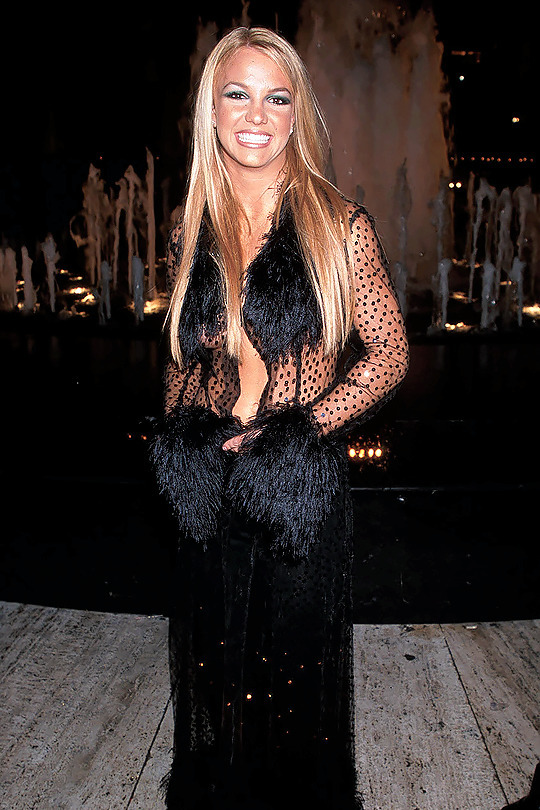

Britney Jean Spears
An American singer. Often referred to as the "Princess of Pop", she is credited with influencing the revival of teen pop during the late 1990s and early 2000s. Spears has sold about 150 million records worldwide, including over 70 million in the United States, making her one of the world's best-selling music artists.
She has earned numerous awards and accolades, including a Grammy Award, 15 Guinness World Records, six MTV Video Music Awards, seven Billboard Music Awards (including the Millennium Award), the inaugural Radio Disney Icon Award, and a star on the Hollywood Walk of Fame. Her heavily choreographed videos earned her the Michael Jackson Video Vanguard Award.

After appearing in stage productions and television series, Spears signed with Jive Records in 1997 at age fifteen. Her first two studio albums, …Baby One More Time (1999) and Oops!… I Did It Again (2000), are among the best-selling albums of all time and made Spears the best-selling teenage artist of all time.
With first-week sales of over 1.3 million copies, Oops!… I Did It Again held the record for the fastest-selling album by a female artist in the United States for fifteen years. Spears adopted a more mature and provocative style for her albums Britney (2001) and In the Zone (2003), and starred in the 2002 film Crossroads. She was executive producer of her fifth studio album Blackout (2007), often referred to as her best work.
Following a series of highly publicized personal problems, promotion for the album was limited, and Spears was involuntarily placed in a conservatorship.

Subsequently, Spears released the chart-topping albums, Circus (2008) and Femme Fatale (2011), the latter of which became her most successful era of singles in the US charts. With "3" in 2009 and "Hold It Against Me" in 2011, Spears became the second artist after Mariah Carey in the Billboard Hot 100's history to debut at number one with two or more songs.
She embarked on a four-year concert residency, Britney: Piece of Me, at Planet Hollywood Resort & Casino in Las Vegas to promote her next two albums Britney Jean (2013) and Glory (2016).
In 2019, Spears's legal battle over her conservatorship became more publicized and led to the establishment of the #FreeBritney movement. In 2021, the conservatorship was terminated following her public testimony in which she accused her management team and family of abuse.
In the United States, Spears is the fourth best-selling female album artist of the Nielsen SoundScan era, as well as the best-selling female album artist of the 2000s. She was ranked by Billboard as the eighth-biggest artist of the 2000s.

The singer has amassed six number-one albums on the Billboard 200 and five number-one singles on the US Billboard Hot 100:
"Baby One More Time", "Womanizer", "Hold It Against Me", and "S&M" (Remix). Other hit singles include "Oops!… I Did It Again", "I'm a Slave 4 U", and "Toxic". "
Baby One More Time" was named the greatest debut single of all time by Rolling Stone in 2020. Time named Spears one of the 100 most influential people in the world in 2021, with Spears also placing first in the magazine's reader poll.
Reprinted in part from Wikipedia
4 notes
·
View notes
Text

Box Office: How ‘F9’ Sped to Record $70M U.S. Opening
The ninth installment in the 'Fast and Furious' franchise scored the biggest launch yet of the pandemic era.
Waiting to rev up the engines was worth it for F9.
When the COVID-19 crisis struck in the U.S., Universal decided to push back the ninth installment in the Fast and Furious franchise by a full year, versus taking a chance on the latter half of 2020 as other tentpoles did (unsuccessfully). As it turned out, many theaters didn’t begin reopening until late spring 2021.
Over the weekend, F9 sped to a record $70 million in its North American start, the biggest showing of the pandemic era and the biggest since Star Wars: The Rise of Skywalker in December 2019. The tentpole’s performance is a major victory for Hollywood and theaters following A Quiet Place Part II.
F9 easily surpassed the $60 million domestic launch of 2019 spinoff Hobbs & Shaw, unadjusted for inflation, but couldn’t match the $98.8 million start of The Fate of the Furious in 2017, underscoring that the fragile nature of the box office recovery.
Overseas, where the Justin Lin-directed movie opened several weeks ago, F9 has earned $335 million for a global total of $405 million through Sunday. The movie — costing at least $225 million to produce — should have no trouble clearing $600 million or more, considering it has many major markets in which to open and has only just begun its U.S. run.
Here’s how F9 succeeded in its domestic debut:
Fan Frenzy
Franchise fatigue can easily set in after three or four installments, but nine movies and one spin-off later, the Fast films continue to boast a strong fan base. And, mirroring an ethnically diverse cast, fans are likewise diverse.
Latino consumers made up 37 percent of F9‘s opening weekend ticket buyers, followed by Caucasian (35 percent), Black (16 percent), Asian (8 percent) and Native American/Other (4 percent), according to exit poll service PostTrak.
“Fans consider themselves to be family,” says Universal president of domestic distribution Jim Orr.
While reviews were lukewarm, audiences gave F9 a B+ Cinemascore.
Theatrical Only
Universal stuck to an exclusive theatrical release, versus making F9 simultaneously available in the home and on the big screen — a controversial practice some studios have adopted during the pandemic.
Because of the ongoing impact of COVID-19, Warner Bros. decided to open its entire 2021 slate day and date in cinemas and on HBO Max. No one knows exactly how much this impacts box office, since parent company WarnerMedia doesn’t reveal streamer viewership numbers. Disney is also making some of its event pics available in the home for $30 via Disney+ Access Premier. That includes the upcoming Marvel tentpole Black Widow (July 9).
Paramount’s horror-thriller A Quiet Place Part II is another big win for proponents of an exclusive theatrical release. The modestly budgeted sequel has earned $136.4 million domestically — a pandemic-era best — and $249 million globally against a $55 million budget.
Right Time, Right Place
Capacity restrictions were lifted in time for F9 in many major markets, including Los Angeles and New York, the country’s top two markets in terms of box office revenue. Mask requirements have also eased dramatically, with all of the major circuits saying vaccinated customers don’t need a face covering at all.
To boot, roughly 80 percent of theaters in North America are now reopened, or 4,647 locations, according to Comscore. Many of those still closed are in Canada, including Toronto.
Moviegoer Comfort Level
Leading research firm National Research Group has been polling moviegoers since the pandemic began. Those who feel comfortable returning to theaters has increased dramatically in recent weeks, and now stands at 77 percent to 78 percent, versus less than 50 percent throughout much of the past year.
Premium Formats
Imax locations and premium large format venues saw brisk sales, which mean more money for all involved because of a ticket upcharge. Imax alone delivered $5.5 million from 378 screens the U.S. and Canada, or 7.8 percent of F9‘s total domestic debut.
That’s a pandemic-era best for Imax. AMC Theatres, the country’s largest exhibitor, also recorded record traffic since reopening its locations. More than 2 million people came came through its doors in total, with many seeking out premium formats, whether Imax, Dolby Cinema and Prime.
#movie magic#movies#movie news#news#fast and furious#f9#vin deisel#natalie emmanuel#tyrese gibson#ludacris#john cena#fast saga
4 notes
·
View notes
Text
Actor Casey Affleck Reflects On The Past And 'The World To Come'
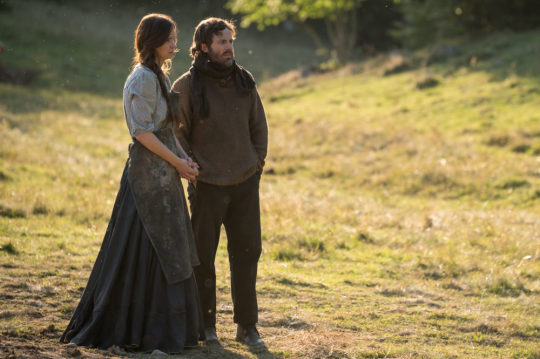
The last time I saw Casey Affleck was after an 8:30 a.m. Sundance Film Festival screening of “Manchester by the Sea,” which left my colleagues and I so emotionally drained we were pretty much useless for the rest of the day. Affleck finds this very funny. “Oh man, that’s awesome,” he laughs. “That was a tough screening. At Sundance I’m usually just going to sleep at 8 a.m.” We’re talking on the phone a few days after the festival’s virtual premiere of his latest movie, “The World to Come,” which made its Sundance debut last month under very different circumstances. “It’s so strange doing these things sitting in front of your computer,” he sighs.
Directed by Mona Fastvold, “The World to Come” is a powerful period piece about a forbidden love affair between pioneer women played by Katherine Waterston and Vanessa Kirby, set in upstate New York during the early months of 1856. Affleck produced the picture, in which he plays a supporting role as Waterston’s uncomprehending husband, and he did his best to soldier through a crowded Zoom Q&A after the Sundance screening, with results pleasant enough, but nonetheless missing that in-person festival magic. “I used to love going to film festivals and talking to journalists and seeing all the movies and talking to other filmmakers,” he laments. “Sitting here alone in a little office in my house is such a drag. But it was nice to know that the movie was getting seen, at least.”
While big brother Ben plays Batman in studio pictures, Casey has exhibited a restless independent streak ever since he was a student at Cambridge Rindge and Latin School. (Our ninth-grade classes competed against each other in the Mass. High School Drama Guild Competition. His won, perhaps unsurprisingly.) A longtime friend of the Brattle Theatre and former creative advisor for the Independent Film Festival Boston, the younger Affleck has always seemed more at home in indies. Not a lot of actors would follow an Oscar-winning role in “Manchester by the Sea” with a microbudget art film like “A Ghost Story.” But then his internalized, minimalist acting style is often at odds with the concerns of contemporary blockbusters. There’s a weird dissonance watching something like Disney’s hokey Chatham sea adventure “The Finest Hours,” with Affleck going full Montgomery Clift while surrounded by CGI silliness.
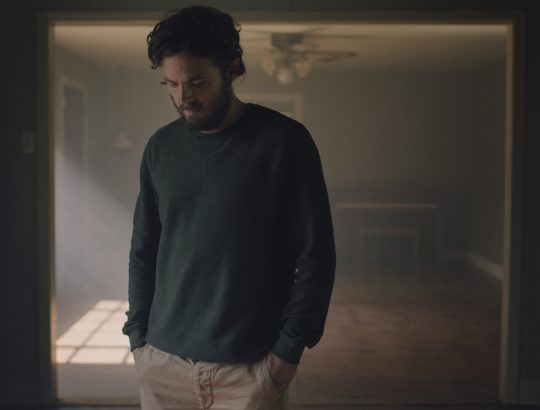
“The World to Come” is the most ambitious project yet from Affleck’s Sea Change Media, which partnered with Pamela Koffler and Christine Vachon’s legendary NYC indie institution Killer Films for the arduous production that began with a conversation between Affleck and novelist Ron Hansen nearly a decade ago. “When I did ‘The Assassination of Jesse James by the Coward Robert Ford’ I got to know Ron Hansen, just because I loved the book so much. Ron has a very unique talent for writing 19th century language. He’s just from another era. I asked him if he had something he wanted to work on together, and I thought he would send me one of his things. Instead, he sent me this story by Jim Shepard. It was beautiful. I said, why don’t you and Jim write the script? And they took about six years, but it came together beautifully. Good things come to those who wait, I guess.”
The film eventually shot in Romania with a break built into the schedule to accommodate the changing seasons that are so crucial to the movie’s rugged, outdoor textures. “We were way out in Transylvania, out in the mountains,” Affleck explains. “We were just in some valley and they built a couple of farmhouses. I like being far away in a new place. It makes you feel outside of your life. And I love working in weather. There are so many aspects of moviemaking that are artificial, but when there’s extreme weather, it’s real. I did this Disney movie about a boat rescue, and it was, like, December in friggin’ Quincy and they were just soaking us with water every single take. There’s not a lot that you have to quote-unquote act. You’re just standing there, teeth-chattering, shivering, just being.” This reminds me of the scene in “Manchester” when he and Lucas Hedges have an argument walking in the blistering cold and can’t remember where they parked. “I forgot about that one,” he laughs.
I’d never say so on the phone, but I consider Affleck’s performance as Lee Chandler in “Manchester by the Sea” among the finest I’ve seen in my 22 years of reviewing films, worthy of discussion alongside Brando’s Terry Malloy in “On the Waterfront” in its aching, inchoate longing. Lee holds his grief somewhere very private and dear, as if to begin to forgive himself would be an act of betrayal. The movie nails a gruff, emotional constipation popular among men of a certain stripe, especially in New England. (My mother offered my favorite review of the film: “Why don’t they just talk to each other? Jesus, this is like watching you and your father.”) Words don’t come easily to most of Affleck’s movie characters, but he chafes at the description of them as inarticulate. “It’s funny, I find the characters in ‘Manchester’ to be sometimes very articulate,” he argues. “There’s misunderstandings, but they end up communicating what’s inside.”
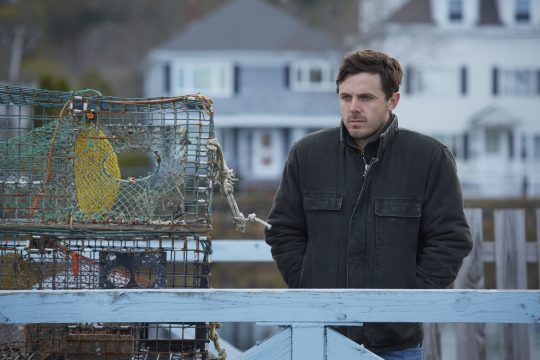
“The World to Come” is rife with such mixed signals and miscommunications, about which co-star Katherine Waterston raved during the Zoom Q&A after the Sundance screening. “It was so much fun to play the scenes with Casey,” she said. “A lot of these scenes are written as dances, where somebody tries to reach out and engage and they’re misunderstood. Inarticulacy is a very interesting thing to see in film. The failed attempts. Failed communications. It’s actually fun to play those things. You don’t know what the other person’s going to throw at you. It keeps it really alive on set. Mona and I felt if we had the money we could have kept shooting this thing for months, because the scenes were so much fun to explore.”
Affleck agrees. “When Katherine’s character writes in her journal or she starts talking to Vanessa, they have this beautiful, expressive way of speaking to each other,” he enthuses, whereas his character “says what he’s gotta say in as few words as possible. He’s very brusque and curt, which I enjoyed. The way that he talks is the communication equivalent when he gives her a birthday gift of sardines and a tin of raisins.”
Indeed, her increasingly florid diary entries — originally intended as a ledger to keep track of the farm’s monthly expenses — become the heartbeat of the film, providing an emotional release otherwise suppressed by the rigid formality of the era and the ugly drudgery of day-to-day farm life. “The World to Come” is ultimately a movie about the need to share our stories, and how through telling them we make sense of ourselves. As producer Koffler explains in the press notes, “Part of the film’s vision is to dramatize a very basic human impulse: to create, to connect, to say ‘I was here, and I mattered.’”
This has become a recurring theme in Affleck’s recent work. In 2019, he wrote, directed and starred in “Light of My Life,” a little-seen but strikingly tense post-apocalyptic road movie about a father and daughter hiding out in the wilderness after a pandemic has wiped out most of the women in the world. The film begins with Affleck telling the little girl a bedtime story that runs almost 13 minutes and sneakily sets up the movie’s major themes. Then in last month’s well-acted but regrettably soggy “Our Friend,” he starred as real-life journalist Matthew Teague, whose soul-baring Esquire story about his wife’s struggle with cancer became a national phenomenon.
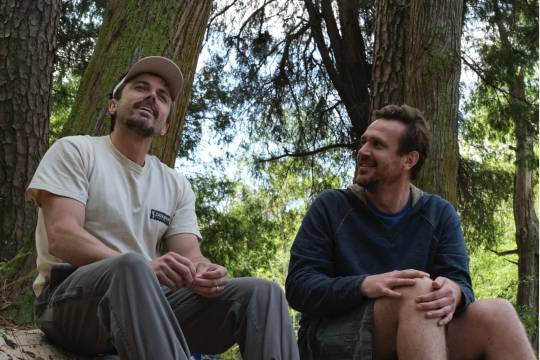
“Matt Teague wrote that article and then wanted it made into a movie as his way of processing everything that had happened,” the actor elaborates. “You transform pain into other things as you go through life. That was all him working through it. I like stories about storytellers and I like stories within stories. Obviously, I wrote and directed a movie that starts with a 12-minute bedtime story. I love that. I know that other people don’t love it as much as I do, so I have to be careful about it.”
That kind of love led to last summer’s “Stories From Tomorrow,” a project initiated during lockdown by Affleck and his schoolteacher mom Christine, encouraging children to send in poems and short stories to be read on social media by celebrities like Matt Damon and Jon Hamm, as well as his “The World to Come” co-stars Waterston and Kirby. “That was something I started out at the very beginning of the quarantine as a small project to encourage kids to write creatively, because I know it can be a great way of processing anxiety and working through feelings that you aren’t really talking about or aren’t aware that you’re having. It wasn’t something I thought would go on forever; once the kids are back in school that ought to be where they should be doing all that kind of work. But while they were sitting at home, I thought it would be a good way to get their attention off the awful news and into something more imaginative. And I also got a chance to read all these super-cool stories! Really creative stuff that kids sent from all around the world.”
Finally, as a Boston publication it would be dereliction of duty not to mention the hysterical Dunkin Donuts commercial parody from when Affleck hosted “Saturday Night Live” in 2016, so dead-on in its depiction of a local 'regulah customah' that on one of my critics’ poll ballots that year I tried to nominate the sketch for Best Documentary. Alas, the performer shoots down a pet theory I’ve been hanging onto ever since, that the dirtbag Boston guy in the Bruins hat is secretly a grown-up version of Affleck’s scene stealing, bug-swallowing Morgan from “Good Will Hunting.”
“I hadn’t thought about that, dude. That’s really funny. It never crossed my mind." He pauses before confiding, "I wasn’t that great on SNL… I just wasn’t all that funny on the skits, because it’s live and you’re reading the cue cards and it was my first time. But when we went to make that little pre-recorded short film of the Dunkin’ Donuts ad, I really felt like that was my wheelhouse there. I could’ve played that character in a movie. I could have gone to work and played him every single day, and I would have had a blast. That was really fun to do. I would love to do another one of those. That would be funny to see that character again.”
I bet that guy’s got some stories.
“The World To Come” is now in theaters and will be available via video on demand Tuesday, March 2.
[source]
3 notes
·
View notes
Text
Japan World Heroes II Day One Part 3: Double Reds and Hollywood Kaiju Men
Unfortunately, most of my photos of the Double Red panel were either blurry or unable to be loaded and had to be deleted as corrupted files. They suffered the same fate as the time I encountered the beautiful Cadillac Sixteen concept car at the Pittsburgh Auto Show years ago, a digital memory slain by flawed tech.
I still remember it sitting majestically on a black marble pedestal with soft running water surrounding it, its massive V16 1,000 HP engine purring like a panthress. All the while envious of the guy who got to drive it up to its elegant stone display. But as they say online: pics or it didn’t happen. (even if it did). Sorry, just went on a tangent. Back onto it...
Nevertheless, it was a lighter panel in details than the others from having two guests at the same time (Mr. Sainei and Mr. McLaren). Mr. McLaren (Jack aka SPD Red), stated he was surprised by how DekaPink would take baths when watching a few episodes of Dekaranger in preparation for his role, something like that would never work in the USA. Both of them talked about Koichi Sakamoto briefly and how influential he is on both sides of the Pacific in toku media. They then did a discussion of the Japanese dub of Power Rangers SPD. Mr. Sainei said that he admired Mr. McLaren’s dreadlocks, which was a non existent hairstyle among the Japanese until SPD came along according to him and has since gained small popularity among eastern Sentai fans (that certainly explains Leo in Zyuohger).
Mr. Sainei says he has the dub of SPD to thank for how Ban is portrayed post-series, as he made his character more calm and mature after doing Jack’s dub voice and finding it was also more reserved and calm than Ban was. Ban’s character is meant to be an upstanding police officer first and a superhero second, using the law to uphold the peace and act on instinct. He also confirmed that any Deka vs. Sentai films are alternate realities that do not fit the Dekaranger or Super Sentai show canon.
Mr. Sainei said he first got into Super Sentai with Changeman as a child, though he admitted he wanted to grow up to be a pro wrestler when he was a kid.
Mr. McLaren initially turned down the role of Jack twice so he could star on an ABC show called The Date. The network hated the show and it was doomed from the start, so finally Mr. McLaren accepted the role of a Red Ranger in a Disney backed Power Rangers show.
Mr. Sainei revealed that to this day in Japanese fan polls, Dekaranger is second only to Shinkenger in terms of popular Heisei Super Sentai shows. This is why the show gets spinoffs long past its original airing such as the Space Squad movies. He also confirmed there are no new Space Squad projects planned at this time or ever unless Toei says otherwise in the future. Mr. McLaren said his agent hasn’t contacted him about the Battle for the Grid video game when asked if he would be in it and if he hasn’t heard of it, he isn’t in it. Mr. McLaren ended the panel by saying that Power Rangers was challenging to work on as you had to build a relationship with the cast over a year and Ryuji Sainei agreed that is the hardest part, especially when starting out.
We got to see Ryuji do his DekaRed morph, but Mr. McLaren left as he had to get back to Hollywood for work.
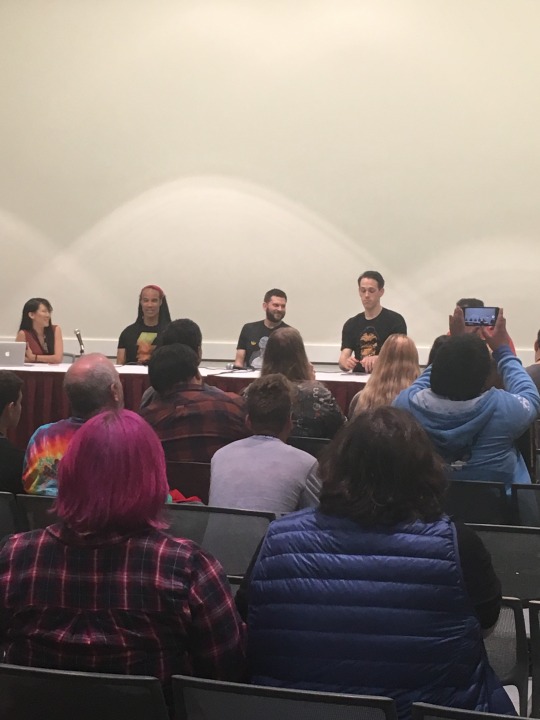
Up next were the suit stars of the recent Godzilla: King of the Monsters film. I am ashamed to admit I faded in and out during this one from hunger (mmmm...In-N-Out).
T.J. Storm was so much of a G-Fan that it resonated from the room. Despite the film’s critical failure, he knows true Godzilla fans loved it from talking to them and that is all that matters to him as he doesn’t care what others think. And he joked that Godzilla loves to take long naps until he’s needed (can’t say I blame the King, he’s almost 70.)
T.J also said that he doesn’t do his role “professionally”, you are basically a man trying to be a kid again and pretending to be a city crushing dinosaur for fun, that is why he loves his job. He, Richard Dorton, Alan Maxson, and Jason Liles then briefly demonstrated what its like to do motion capture without the suits, with the normally sweet and friendly Mr. Storm getting into character and letting out a terrifying growl and roar.
T.J. also revealed what I posted earlier about his roles and a bit more, he was Rocket Racoon! Apparently he stopped working for Marvel when they refused to credit him for their projects. He and the others are loyal to Legendary Godzilla for their director of the recent film, who demanded the studio give his mo-cap workers credit and they did eventually get it. So happy endings there. They are also working for Netflix, because again, they are actually credited for their work and treated fairly.
T.J. then told the audience he is an advocate for mo-cap suit actors such as himself and the great Andy Serkis and stuntmen to be recognized at the Oscars, as elites often ignore their efforts for arthouse films in an era where superhero films and action movies are keeping Hollywood afloat financially in terms of the market share of cinema. I asked Mr. Storm how it felt to be part of a 65 year legacy and to follow in the footsteps of people like Haruo Nakajima.
He said he was humbled by it, and he feels he can never fully fill in Nakajima-san’s shoes, but he will always do his best for the fans. He has been a Godzilla and kaiju fan since he was 4 years old when his father took him to the movies to see Godzilla vs Hedorah (Godzilla vs. the Smog Monster), so becoming a thing from his childhood means the world to him.
Sent my mother home after that when she asked for an Uber taxi as she was bored and hungry. I was a bit peckish myself, but endured for the next panel.
#godzilla#t.j. storm#dekaranger#power rangers spd#super sentai#power rangers#motion capture#japan world heroes#convention#tokusatsu#dekared#spd red ranger#kaiju
15 notes
·
View notes
Text
I’ve already got 2 movies on the backlog for liveblogs (Hotel Transylvania for winning the last poll and 101 Dalmatians as a gift for my friend @mandareeboo) but because I like having an idea of what I have to look forward to, soon I’m going to be doing a two part poll for my next Disney movie liveblog after 101 Dalmatians.
The first poll is going to be to pick the Era the movie will come from, since Disney has like 50 movies I consider elligible for liveblogging (I’m not even considering the package films because I wouldn’t have enough to talk about), so this would help narrow it down.
And the second one will be to pick the actual movie. However, I will already say that neither “Meet the Robinsons” nor “Ralph Breaks the Internet” will be options even if their Eras win the first poll. The first one because I already did it, and the second because, well, it’s the only Disney movie that’s actually painful for me to watch.
0 notes
Text
I'm ONLY counting films from the Walt Disney Animations Studios after the "Package Film Era" (post 1949), and ending with Walt's final film. There's some debate on whether the infamous "Bronze/Dark Ages" of Disney began with 101 Dalmatians, or possibly The Jungle Book itself. But for me, the Bronze/Dark Age didn't truly begin until after Walt's death, so for the sake of argument, I'm including the three 60's animated films.
(Before anyone asks, NO, Mary Poppins does NOT count. It is a live-action film with an animated sequence, not the other way around, like Fantasia).
Happy voting! ❤
#Starling polls#Disney Film Era Polls#Disney#Disney Silver Age#Cinderella#Alice in Wonderland#Peter Pan#Lady and the Tramp#Sleeping Beauty#original post#500+ votes#100 notes#200 notes
203 notes
·
View notes
Link
You finally need two hands to count all the current TV shows with Asian American protagonists. Fresh Off the Boat (ABC) and Master of None(Netflix) arrived with fanfare for breaking ground (though a third season of Aziz Ansari’s romantic comedy was uncertain even before the star’s current scandal), while Quantico (ABC) and Into the Badlands (AMC) keeping chugging along, and the comedy Brown Nation (Netflix) and children’s melodrama Andi Mack (Disney Channel) have yet to become blips on the mainstream pop cultural radar. So it’s a bit strange, and off-putting, that the latest series with an Asian lead—one of the most anticipated shows of the year, it so happens—isn’t being described as such. In fact, its network—once a standard-bearer for prestige TV’s lack of diversity—is highlighting the drama’s focus on queerness and homophobia—and by doing so largely erasing its main character’s racial identity, especially in the first half of his story.
The Assassination of Gianni Versace: American Crime Story isn’t about the titular victim but his killer: Andrew Cunanan, a San Diego native born to a Filipino father and an Italian American mother. Writer Tom Rob Smith adapted journalist Maureen Orth’s nonfiction account Vulgar Favors, structuring the episodes in reverse chronological order so we work backward from Versace’s murder. In a recent interview, Smith said of his source material that it “reads very much like an outsider commenting on a world of which they’re not part, and sometimes that can make you seem quite removed from it.” I agree with his assessment; Orth’s book includes lengthy and salacious discussions of Versace’s HIV status and the popularity of meth among gay communities. But Smith’s description could also be turned on The Assassination of Gianni Versace, which is a white writer’s dramatization of another white writer’s interpretation. American Crime Story’s first season, The People v. O.J. Simpson, tackled issues of both race and gender skillfully; there’s no reason why we should accept any less from its second.
The show’s Andrew, played by Darren Criss, does mention his father’s plantation in the Philippines early on. But between his pathological lying and that country’s colonial past, his race isn’t confirmed till about midway through the nine-hour season. A few character details here and there suggest Andrew’s racial self-hatred and the prevalence of anti-Asian racism within the gay community, but the relative sparseness of these implications is all the more noteworthy in contrast with the richly developed portrait of the decade’s homophobia.
Credit where it’s due, even if the bar for praise here is laughably low because Hollywood’s institutional aversion toward Asian stories and characters remains so entrenched: In casting Glee’s Criss (who played Blaine Anderson), Ryan Murphy hired a half-Filipino (if white-passing) actor to play the half-Filipino role of Andrew Cunanan. Criss is excellent, and in later episodes, the Philippines-born Broadway performer Jon Jon Briones is electrifying as Andrew’s father, the sociopathic Modesto, who teaches his favorite child all the wrong lessons about the American dream.
If The Assassination of Gianni Versace feels urgent as it revisits the stifling homophobia of the ’90s, it’s far less successful in reimagining Cunanan from a racialized point of view, at least in the first eight episodes. (The season finale was not provided to critics in advance.) It’s certainly not as if those racial and ethnic depictions of Cunanan don’t exist. In his analysis of the divergent foci of the mainstream American and Filipino American media narratives about Cunanan, scholar Allan Punzalan Isaac notes that the former wagged its tongue about his “deviant” sexuality (Tom Brokaw infamously referred to the killer as a “homicidal homosexual”), while consumers of the latter looked on with a mixture of “pleasure and horror.” The horror is understandable enough. The pleasure, perhaps, is easier to grasp when you’re part of a group whose presence and history are constantly made invisible by the larger American culture. “Perhaps [the Filipino American fascination with Cunanan] stemmed from a longing to be reflected in the small screen in this American media sensation,” Isaac wrote several years after Cunanan’s death. Filipinos preferred participation, he conjectures, in “any American drama, even for the wrong reasons.”
Nearly all of the eight Filipino American scholars, activists, and advocates I talked to for this story say that Cunanan has fallen out of popular Filipino American lore, just as he’s been forgotten by American pop culture until now. Professor Christine Bacareza Balance told me in an email interview that when she polled 40 or so students in a recent Filipino American Studies course, only one or two knew who Cunanan was. But among gay Filipino Americans, he remains something of a cult figure and for a few Filipino American writers, a literary muse. Isaac begins his seminal book about Filipino American identity, American Tropics, with a meditation on Cunanan’s incarnation of many of the concepts central to his subject: the possibility of “assimilation gone wrong,” the fear of rejection and the eagerness to belong, the embodiment of Filipino/American “mestizo” beauty standards, the corresponding ethnic ambiguity. (Isaac quotes a New York Times article describing Cunanan’s face as “so nondescript that it appears vaguely familiar to just about everyone.”) Paul Ocampo, a co-chair of the Lacuna Giving Circle, a philanthropic group that fosters leadership in LGBTQ Asian American communities, offers a more cynical interpretation: “There’s an aspect of the glitter and glitz of Hollywood to this story that attracts many in the Filipino American community more than the macabre.”
It’s important to remember that Cunanan murdered five people, apparently in cold blood. His victims deserve to be mourned. But in the absence of other well-known personages (or the inconspicuousness of many successful celebrities’—e.g., Bruno Mars’— Filipino-ness,), it’s perhaps inevitable that some Filipino Americans see or project certain facets of themselves in one of the very few Filipino Americans to appear on TV and on page 1, especially during that era. Ben de Guzman, a policy advocate in D.C., saw Cunanan on the news and thought, There but for the grace of God go I. “As a young, gay Filipino American man who was around his age when he was in the news,” de Guzman recalls via email, “I was forced to look at how the same forces of homophobia and racism that informed my life must have affected him too.”
The former party boy and escort remains a symbol of queer defiance for some in the gay Filipino American community. “Here was a gay Filipino man who seemed unapologetic and daring in his acceptance of his sexuality,” says Ocampo. “In this, he seemed to exude a self-possession that many people struggle with.” Balance says that the image of Cunanan as a “queer Asian/Filipino American on the warpath” “truly goes against many dominant representations within ‘mainstream’ U.S. media.” Isaac contrasts Cunanan’s narrative with the gay/bi film Call Me by Your Name, which he observes is “set outside the U.S., outside the AIDS scare, outside any class conflict—all part of the Cunanan spectacle.” Isaac seems to anticipate a reckoning as Cunanan’s story unfurls on the series: “How is this story of intergenerational sex, wealth, casual prostitution, and reckless living in the gay demimonde of the ’90s to be received in this age of domesticated gay marriage?”
And if Cunanan’s messy and unpredictable life story seems ripe for fictional inspiration, The Assassination of Gianni Versace certainly didn’t get there first. A decade after Cunanan’s death, novelist and playwright Jessica Hagedorn (a canonical Filipino American writer), along with songwriter Mark Bennett, launched in the killer’s hometown a workshop production of their musical Most Wanted, a thinly fictionalized version of Cunanan’s story that explores media sensationalism and marginalized individuals’ desperation to belong. Smaller-scale works like Regie Cabico’s poem “Love Letter From Andrew Cunanan,” Gina Apostol’s short story “Cunanan’s Wake,” and Jason Luz’s erotic short story “Scherzo for Cunanan” likewise attempt to humanize a murderer who, while deplorable for his actions and indisputably extreme in personality, almost certainly had some desires and experiences common to many Filipino Americans. None of these works add up to a complete portrait, or could. But created from Filipino American perspectives, they explore the aspects of Cunanan’s life that white America still isn’t fully grappling with.
17 notes
·
View notes
Note
literally what makes the aristocats bad. its got nice songs. it has silly characters. it’s got really pretty backgrounds and the old hand-drawn disney animation. it’s inspired by a true story. what’s there to dislike.
(*cough* aside from the racism that permeates most if not all of the old Disney movies but since that’s present in so many of them no special case should to be made against the aristocats for it to be a worse movie because of that shared trait *cough*)
also I hope this didn’t come across as like. confrontational or anything bc it’s not supposed to be. legitimately want to hear your thoughts 👍
No, I love this! I appreciate being asked my thoughts, especially since the good people in the tags have told me loud and clear that I am in the minority on this one.
I will say, I did not expect the poll to have quite the legs it's got on it now. My polls usually only get about 60 votes. If I'd known 4,700 strangers and counting would have an opinion on this, I might have worded it differently. The real reason I didn't include The Aristocats is because I knew it would run away with the thing. Most people consider it a classic, regardless of what my opinions on it actually are. I thought throwing in a cheeky little line about it would be a fun gag for my followers who know I'm a true hater at heart.
Before I even got this ask - and because the overwhelming majority of the tags on the poll are telling me I have no taste - I actually did start rewatching it! Hundreds of strangers on the internet have never been wrong before, right? Part of the problem is I have next to no nostalgia for it. We didn't own the VHS when I was a child, so the only times I ever saw it were when I'd go to a friend's house or borrow it from the library. Maybe my judgement was clouded by not having seen it in a very long time.
First things first: The good stuff. There are parts of this film that rank alongside the best of the Disney classics, and I would be remiss in not mentioning them.
The music, for one, is pretty good. You'd have to be some kind of real Scrooge not to enjoy "Ev'rybody Wants to Be a Cat" of course, but on a rewatch I did find myself grinning through "Thomas O'Malley Cat" as well. This is an easy point in the film's favor though, as I'm an absolute sucker for both big band and jazz. This is great use of your Scatman Crothers and Phil Harris, top points awarded for these two numbers in particular.
The animation is also pretty good. Especially on Edgar and Thomas O'Malley. Your mileage may vary on the Xerox style, but the animation itself is relatively unimpeachable. This was still during the era of the Nine Old Men, so there's all kind of impressive work being done with the big sweeping things like character movement and expression as well as in the more subtle animations like expressions and mouth movement.
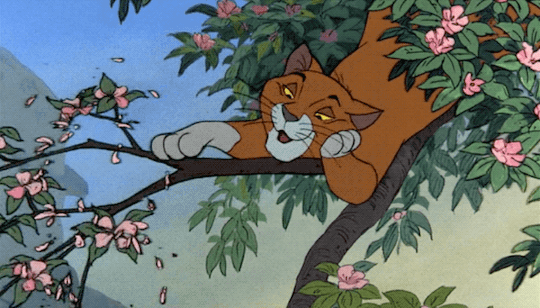
The cats are doing all the cat stuff you'd expect like licking their paws and poof'ing their tails, but there's less expected movements here too, like arching their backs when walking alongside things or rolling in the dirt to dry off from the river. This is good character work, but it's also pretty standard for guys like Milt Kahl and Eric Larson. If you're at all interested in animation, I highly encourage you to read more about the Nine Old Men and their history with the studio.
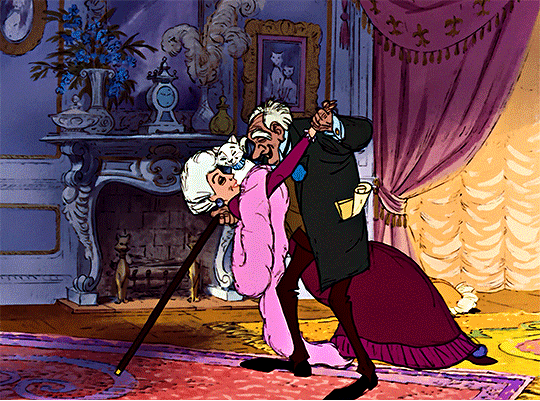
(A big thanks to the tumblr gif artists for gif'ing the parts of this movie that look good so I can spice this post up with some relevant visuals!)
Now, the bad. Like many movies from this era, The Aristocats has something of a pacing problem. While it is necessary to do the work of setting up the conflict in the beginning, you might be surprised to learn that it takes 25 minutes for Thomas O'Malley to show up, which is when the story actually starts.
A huge part of the problem is that this movie suffers from a sort of directionless vignetticism that seems to have been driven only by the idea that it would be cute to see the animals do X, Y, and Z. "Oh wouldn't it be sweet to see the kitten paint?" "Wouldn't it be so adorable if the cat played the piano?" "Ohh, what if the mouse ate a cracker dipped in milk, wouldn't that be darling?" I have a very high tolerance for schmaltz, but The Aristocats is where even I must draw the line.
When the movie isn't being tooth-rottingly sweet, it's frequently boring, and when it's not being either of those things it's showing you another chase scene with the dogs and the butler. It's erratic, tiring, and strains the limits of the modern attention span even at the movie's incredibly sparse runtime. It's a 79 minute film and you feel all 79 of those minutes.
Tonally, much of the movie smacks of the kind of rose-tinted sentimentalism Disney was known (and even criticized at the time) for, but without the guiding hand of the man himself, nearly 5 years gone by this point. The studio was floundering in the wake of Walt's death, and The Aristocats is quite close to the nadir of this particular creative valley - though the distinction arguably goes to Robin Hood, I'm much softer on that film for a number of reasons.
The Aristocats reminds me a lot of Lady & the Tramp, in that it's the same story (down to the aforementioned racist caricatures of Siamese cats), but with cats instead of dogs and with a much less focused sense of purpose, tone, and creative direction. If you like The Aristocats for the music and the beautiful scenery, but you haven't seen Lady & the Tramp, give that one a try instead. The animation is better, the music is about on-par, and it doesn't have as many stupid chase scenes. Or just watch 101 Dalmatians, which outstrips both films on sheer charm alone.
I think I had more I wanted to say, but it was mostly rambling that got away from the point. On rewatch, I don't think this movie is as bad as I remember it being, but I stand by my decision not to include it in the poll.
tl;dr - The Aristocats isn't the worst. If you grew up watching it I totally understand having a soft spot for the music and the atmosphere. In a vacuum, I can't say I think it holds up but ultimately I'm not going to judge anyone for enjoying it. Thanks for the ask!
22 notes
·
View notes
Text
New from Every Movie Has a Lesson by Don Shanahan: EDITORIAL: Lessons on the New Future of Movie Theaters
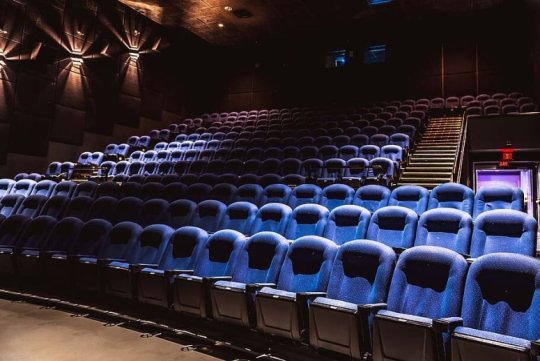
Image: pxfuel.com
During this last month or so of our collective national and international quarantine, I’ve been holding the topic of re-opening movie theaters from my usual “What We Learned This Week” columns on the Feelin’ Film podcast for a “Soapbox Special.” There have been so many articles, so many perspectives, and so many rapidly evolving updates and changes that I couldn’t distill them down into one little lesson or column entry.
With several regions of America starting to re-open (including my own state of Illinois and city of Chicago), it was time to get on the stump and arm the cannons. I put some of what follows into spoken word recently on an episode of Mike Crowley’s “You’’ll Probably Agree” podcast, but the issue has grown since then. Click into the multitude of links in the lessons for the deeper referenced stories. They are well worth their reads and your attention. The theme of this all can be summarized as cautiously optimistic.
LESSON #1: WHAT WOULD IT TAKE TO GO BACK TO THEATERS — I’ll open this rant back in late May with polling from Variety. It featured a survey of consumer comfort. Here are some bulleted results in numerical order:
91% requested hand sanitizer stations
90% say the most important factor is a cure for COVID-19.
86% supported limited screenings for cleaning time
75% support employees temperature checks
70% would rather watch a first-run feature at home
61% would feel better about mandatory face coverings
60% support audience temperature checks
47% were comfortable buying concessions
46% were comfortable using public restrooms at theaters
There’s more there in that article, but those were the highlights. Beyond even that poll, you’ve got more and more segments of the population who won’t feel comfortable with any public event, let alone a movie, without a vaccine in place. Putting any number of these initiatives in place would be costly, especially for theater chain companies reeling on the edge of bankruptcy.
LESSON #2: WHAT DOES THAT FUTURE LOOK LIKE — Any of those changes from Lesson #1 would make for a very different setting than the “normal” way we’ve been going to the movies for the last century. Many editorials and articles (Seattle Times in May, Vulture in May, and Quartz in June) have tried to talk that out exhaustively with every guess in the clouds. For example, many of us have embraced reserved seating as a way to select our spots, skip crowds, and guarantee seats even if we walk in last minute to avoid 20 minutes of senseless trailers (I know that’s not just me, *wink*). The activity timeline changes upward if we are to stand in a line for temperature checks and even downward if there are no concession lines or needs anymore, which is a tremendous business hit to the theater chains that have been bolstering their kitchen capabilities and choices beyond candy and popcorn for the better part of the last two decades. The other word in there everyone wants to avoid is “crowds.” Can that be accomplished with roped off sections, skipped seats, or an all-reserved seating model (which some older theaters don’t fully have)? In the meantime, you’ve got companies fumbling financial footballs and poking public outcry bears (bravo Michael Phillips) over requiring or not requiring masks (and reversing courses) and other measures before they even open. Do you really trust them to get all of this right on the first try here in July?
LESSON #3: THE OPTION OF AUTOMATION — Piggybacking off of Lesson #2, one potential solution could be artificial intelligence, as crazy at that sounds. According to Variety in May, some theaters in Korea were considering “contact-free” technology. Theater chain CJ-CGV replaced its human staff with AI robots and automated kiosks for scanning and handling ticket transactions. Concession stands were replaced with app-powered and LED-controlled pick-up/delivery boxes. Leave it to tech-savvy Asia to be the tip of that spear. Could the likes of AMC or Regal pull stuff like that off, again, while teetering on financial failure? How do data-danger-minded consumers feel about that?
LESSON #4: COMPANY SURVIVAL IS PERILOUS — The first three lessons constitute a forecast and some great ideas, but who or what can afford those measures? After months of virtually complete closure, save for some door-front concession hawking, large theater chains, especially AMC (which includes the Carmike brand), are in the financial toilet. Bailouts and loans are hard to come by and “junk” status is hitting stock reports. You even have Amazon interested in gobbling up AMC, which would be quite interesting. It may require a rescue such as that. This peril is international as well with CineEurope reporting a possible $20–31 billion loss for the year. Even reopening isn’t an instant cure. The majority of profits for these companies are dependent on concessions because of the high ticket receipt percentages going back to the studios, a gouge that has been increasing over the years at the high blockbuster level (Thanks, Disney). If the food areas are closed due to viral fears and health code regulations, that destroys earnings. 50% capacities of social-distanced seating doesn’t help theaters either. Even 50% might be optimistic. There are theaters opening at barely 25% capacity.
LESSON #5: “TOO BIG TO FAIL” IS LOOKING FAILURE STRAIGHT IN THE FACE — And with that we reach the studios’ level of wallet hit with an inactive theater distribution market. Even with their demanded big bites of the pie, half-filled (or less) theaters do not help them either. This is especially the case at the blockbuster level. No matter the anticipation demand or potential staying power of a really big hit flick with less competition, it is exponentially harder to recoup $200 million-budgeted tentpoles and their $100+ million marketing campaigns if sizable fractions of the screens holding butts are gone or entire chains are shuttered. That’s why the really big stuff like Tenet, Mulan, Fast 9, No Time to Die, and more are not automatically landing on streaming services or VOD outlets. Even at a Trolls: World Tour-equivalent $20 price tag per rental (and its modest success), those giants cannot recoup those huge red balances versus getting a ticket for every head instead of every household. A little thing like The Lovebirds or Irresistible can land in the green with VOD, but not Wonder Woman or Black Widow. A business with a blockbuster class level of movies that once looked too big to fail making its worldwide billions is now failing because they have no place to go and no one able to come to their shows.
LESSON #6: STUDIOS DID SOME THIS TO THEMSELVES — Believe it or not, the studios have slowly damaged their own theatrical success/potential for years with the incremental shortening of the windows between big-screen premieres and home media release dates. Folks my age remember the months of interminable wait back in the VHS and cable TV eras before streaming services were even a glimmer in someone’s eye. For example, Forrest Gump hit theaters over the July 4th weekend of 1994. It didn’t land on VHS until late April 1995 after a long theatrical run and a winter Oscar bump. After that, it wouldn’t hit paid cable for another bunch of months and then years before basic cable made it “free.” By comparison, Joker opened on the first weekend of October last year, hit store shelves the first weekend of January 2020, and no one cares if it comes to HBO or Showtime because Netflix, Hulu, or VOD is cheaper and better. What used to be six months at the minimum (or even an entire year if you were a Disney release) has shrunk to merely 90 days on average. Sure, both Forrest Gump and Joker raked for their times, but it’s an indictment on patience versus money-grabbing. People that are willing to wait can now weather a pretty comfortable amount of time compared to the past for their 4K players and big-screen TVs in their dens. In our current COVID-19 state, we’ve all got nothing but time on our hands to do just that. Why risk health if personal patience versus some “fear of missing out” can pay one $20–30 digital download/disc price to watch a movie repeatedly instead of hauling the entire family plus concessions once, especially for something they don’t deem “big screen worthy?” The studios trying to keep the buzz constant with shorter waits will now see leverage backfire in favor of the consumer. For a current case of that, just look at Disney/Pixar’s Onward and the mere weeks it took to cave from the VOD rental level to dismissively dishing it to everyone in Disney+. With studios building their own streaming shingles, you’re going to see more of that or see more wins for Netflix, Hulu, and Amazon.
LESSON #7: THE PRICE POINT OF DIGITAL — Let’s go further with the digital wants of consumers versus the new risks and hassles of theaters. Circling back to that opening Variety polling again, remember that 70% would rather watch a first-run feature at home. And that was back in May. Imagine now knocking on the door of Independence Day, no matter how much antsy-pant anticipation and hope is out there. That same Variety polling screened respondents on online pricing with some keen results. It asked how much a “reasonable” price would be to stream top-quality productions in their home. Here are those results in numerical rank:
47%- $10
20%- $20
19%- only if it was free
6%- $30
3%- $40
1%- $50, $60, or $80%
That’s 67% holding firm at $20 or under and studios need to do their own projections of math. Regardless, welcome to a more than a little bit of the #firstworldproblems portion of this entire “Soapbox Special.” Movies are wants, not needs, period. They are lovely fulfillment, but non-essential. For every one of those 6% hardcore FilmBros and cinephiles with the disposable income to drop $40 or more to see their precious Christopher Nolan film, over 95% aren’t budging or can’t afford it. Check your privilege.
LESSON #8: ADAPT OR DIE — One way or another, change is needed at the highest level that trickles down to every screen in America. A popular industry that has weathered the advent of television, cable, and now streaming opponents and competition in its century of existence should be able to survive this. Or can they? With the Paramount Accords lapsed, is it time for studios to buy or build their own sustainable theaters to show off their own wares and keep all the profits they used to share with the chains? If studios instead mine the digital landscape successfully, do we really need multiplexes anymore? That is a question posed recently in The New Yorker by Richard Brody in a good read. They’ll need smaller budgeted films to do that, scaling so many things down. Go back to the roots. You can make a dozen solid indies or five or more star-driven mid-budget programmers like the industry used to do in the 1990s with the cost of a single MCU film. Reverting back to that level of business would require some baths and haircuts, but it would rescue the industry. It’s time to embrace those needs. In another angle, columnist Nick Clement on Back to Movies says the film industry is “f — ked.” In many respects, I highly agree with him and his fantastic stump piece speaking on unemployment and the public state of some of those aforementioned #firstworldproblems. Time and patience are the biggest needs.
LESSON #9: “ABSENCE AWAY MAKES THE HEART GROW FONDER” — I’ve used this lesson before in “What We Learned This Week” and it’s time to end with it again. Shed away all the polling and conjecture. We all know the love for movies is there or we wouldn’t be talking about it. Look at the success of early openings and the lined-around-the-block comeback of drive-in movie theaters. It will be a topsy-turvy year, without question, even with a full return. We’ve had a zero-budget film named Unsubscribe streaking at an empty box office only to be dethroned by revival screenings of Jurassic Park putting it back to #1 in the nation, George Foreman-style, 27 years after it last ruled the multiplexes. If the year ended today, Bad Boys For Life would get the “biggest movie of 2020” championship belt in the record books. Just like Field of Dreams says, “people will come.” They just need to wait. Everyone, for that matter, from the greedy studio execs and sidelined movie stars to the lowly theater ushers and concession stand workers, needs to wait. This has sucked and it will keep on sucking, but the best answer is to wait and get through this better and healthier, personally and financially, than rushing and screwing it all up. The movies will be there. We want all the people to be there too.

LOGO DESIGNED BY MEENTS ILLUSTRATED
Permalink
from REVIEW BLOG – Every Movie Has a Lesson https://ift.tt/2BHtPlF
via IFTTT
from WordPress https://ift.tt/3i8582e
via IFTTT
0 notes
Text
Disney cuts same-sex kiss from Star Wars: The Rise of Skywalker’s Singapore release - hollywood

Disney has cut a lesbian kiss from the latest Star Wars movie - one of the top Christmas films - Singapore's media regulator said on Tuesday, so that more children can watch it.The two minor female characters embrace but do not kiss in the version of The Rise of Skywalker shown in Singapore, local media said, as the ninth and final film in the celebrated science-fiction series rakes in millions from loyal fans."The applicant has omitted a brief scene which under the Film Classification Guidelines would require a higher rating," a spokeswoman from Singapore's Infocomm Media Development Authority told the Thomson Reuters Foundation.Disney, which owns the Star Wars production company Lucasfilm, did not respond to a request for comment on its decision to cut the scene from the last installment of the second highest-grossing movie franchise of all time.It concludes a story that began in 1977, when filmmaker George Lucas introduced a young hero named Luke Skywalker and delighted audiences with a galaxy of robots, furry warriors known as Wookiees and a host of other eclectic characters.Also read: JJ Abrams on mixed reactions to Star Wars-The Rise of Skywalker: ‘Everything immediately seems to default to outrage’Sex between men is illegal in Singapore and punishable with up to two years in prison, though the British colonial-era law is rarely enforced. The law does not apply to sex between women. Singapore activists challenged the law last month as polls suggested attitudes toward homosexuality are softening and similar legislation was scrapped in India last year.The film is rated PG-13 in Singapore without the kiss scene, meaning parental guidance is advised for children below 13. Higher ratings mean it could be restricted only to viewers aged 16, 18 or 21 and above.In 2016, the Singapore organisers of the musical Les Miserables removed a scene in which two male actors kiss after complaints from the public.Disney declined to respond to a question about censorship in other markets, including the Middle East, amid media reports that lesbian kiss has also been deleted from screenings of The Rise of Skywalker in Dubai in the United Arab Emirates. Follow @htshowbiz for more
Read the full article
#$5entertainmentbook#$5entertainmentcouponbook#0151entertainment#08.05entertainment#1entertainmentbedford#1entertainmentbouncycastle#1entertainmentdj#1entertainmentevents#1entertainmentinc#1entertainmentltd#1entertainmentmusicandmanagementgroup#1entertainmentpass#1entertainmentreviews#1entertainmentsittingbourne#2entertainmentmanagementltd#2entertainmentnews#2/0entertainmentcable#3artsentertainment#3ballentertainment#3entertainmentproducts#4entertainmentawards#4entertainmentcreditcard#4entertainmentgroup#4entertainmentgroupllc#4entertainmentgrouplosangeles#4entertainmentjobs#4entertainmentlogo#5entertainmentab#5entertainmentcenter#5entertainmentcompanies
0 notes
Text
5 Things Everyone Gets Wrong About movies counter .com
1. Fruit Within the Looms
two. Python’s Give Reside Birth
three. The Toad Elevating Minute
four. Mystery In the Dropped Python Sketches
five. Brian’s The Lifetime of The Occasion
six. Kim Bread Aka John Cleese
7. Around The World In 80 Times
8. Get Your self To Mars
9. Retain It Real
ten. The 12 Fisher Monkey Kings
eleven. Parting Shots
one. Fruit Inside your Looms
A person once stated a thing movies counter hindi dubbed alongside the lines that, Monty Python will be to ‘amusing’ what chartered accountants are to ‘tedious’. Who are we to disagree?
The legend of Monty Python emerged nobly within the dusty corridors of Oxford and Cambridge universities. Every one of the British Python users experienced their comedic commences in revue displays placed on by these universities. They soon rose to the ranks of obligation inside of these societies, “In bewilderment we observed a notice board informing us that we at the moment are officers!” recollects John Cleese.
Their very well-acquired exhibit, A Clump of Plinths, transferred to London’s West Conclusion and afterwards frequented New
Zealand and Ny under the new title Cambridge Circus.
Cleese stayed on in Big apple And through a photo shoot for a comic strip he fulfilled American illustrator Terry Gilliam. Terry was quickly folded to the each and every growing omelet.
The BBC, on the recommendation of producer Barry Took, signed the team – which now incorporated Eric Idle and Terry Gilliam for your thirteen-clearly show sequence. Ah, but what to name the display?
Owl Stretching Time. A Horse, A Spoon and also a Bucket. The Toad Elevating Moment ended up all names from the managing. But as planning for your series grew to become far more chaotic, the BBC administration began to check with the team like a ‘flying circus’, encouraged via the Red Baron’s World War 1 fighter squadron. The Movies-Counter.Site troupe preferred the audio of it and randomly extra the phrase Monty Python from their expanding list of alternates. Humorous that.
No one knows what took place to them.
Oh wait, 3 new sketches of never ever prior to noticed Python materials were lately identified and performed with the Edinburgh Fringe Competition. The famed sketches were being composed by late Python star Graham Chapman and were being unearthed by a literary executor in L. a.. Each and every sketch lasts 4 minutes and includes a Forged of characters which includes a gay parrot and an overworked Messiah.
Monty Python’s Life of Brian snagged the funniest film of all time inside of a poll organized by Complete Movie magazine.
The movie satires the increase of organized faith and prompted far more controversy than the usual Kevin Smith baptismal when it was produced back in 1979. It was banned in several portions of the united kingdom and church leaders accused it of blasphemy. Very little like undesirable publicity to push the rankings.
Their King Arthur era spoof, Monty Python as well as the Holy Grail, trailed by just a few spots, landing it at amount 5.
Leading ten Comedy Movies
1. Lifetime of Brian
2. Plane!
3. Withnail & I
four. There’s A little something About Mary
five. Monty Python and the Holy Grail
six. American Pie
7. Groundhog Day
eight. Some Like it Scorching
9. Blazing Saddles
ten. Planes, Trains and Cars
John Cleese rode a roller coaster of fame during the 1970’s participating in the part of pressured hotelkeeper Basil Fawlty in Fawlty Towers. He continued his fame with films like Privates On Parade and Clockwise, then strike all over the world stardom with a A Fish Called Wanda in 1988. The observe-up movie, Fierce Creatures faulted to gain interest with audiences. Nowadays audiences know him finest as the new Q while in the James Bond movies and Virtually Headless Ned during the Harry Potter films. He'll upcoming be viewed playing father to Lucy Liu in Charlie’s Angels: Comprehensive Throttle and because the voice Fiona’s Father in Shrek 2, Fiona is voiced by Charlie’s Angel’s co-star Cameron Diaz.
Michael Palin has also rocketed to fame due to his turn With all the troupe As well as in 1977 he teamed with Terry Jones for making their particular comedy series, Ripping Yarns. Michael also appeared aside John Cleese in A Fish Known as Wanda, then went on to complete a truth show for BBC Television, called Around the globe in eighty Days, where by he tried to actually observe during the footsteps of your Jules Verne literary character, Phileas Fogg, by attempting to travel worldwide while in the allotted time, but without the need of flying – By the way, it’s Jules Verne’s 175th birthday this week. Throughout the Pole to Pole trip, he met up with Python lovers in Greece and ate snake in China while battling to satisfy his deadline.
Eric Idle ongoing his stint in the limelight by teaming with Neil Innes to generate Rutland Weekend Television, a parody of regional broadcasting. He later on appeared in Graham Chapman’s Yellowbeard, Disney’s Honey, I Shrunk the Audience and Splitting Heirs. His new novel titled, “The Highway to Mars” is about two comedians during the twenty second century. Supporters most likely know him nowadays given that the voice of Mr. Vosknocker during the animated movie, South Park: Larger, Lengthier and Uncut.
Terry Jones preserved a variety over and above mere comedy, by producing about historical past, presenting documentaries, penning kids’s textbooks and likely onto direct the 1996 Variation of Wind within the Willows, starring his previous pals – Michael Palin, John Cleese and Eric Idle.
Terry Gilliam lent his abilities to the troupe to be a director and by generating the quite unique animations that grew to become Monty Python’s visual trademark. We shortly followed it together with his aspect film debut, Jabberwocky, starring Michael Palin. Following helming the Considerably loved, Time Bandits, his fame skyrocketed in Hollywood. But his design led to quite a few conflictions while in the biz like an enormous toss down with Universal Studios in excess of his film Brazil and afterwards problems with backers around the extremely highly-priced, Adventures of Baron Munchausen, which starred Eric Idle and showcased Robin Williams.
His actual achievement followed by taking up unconventional studio films including the critically acclaimed, The Fisher King starring Robin Williams and Jeff Bridges and also the stylistic sci-fi thriller, twelve Monkeys starring Bruce Willis and Brad Pitt plus the Hunter S Thompson extravaganza, Fear and Loathing in Las Vegas starring Johnny Depp and Benicio Del Toro. These 6 actors all gave a few of the very best performances in their job in Gilliam’s films.
“We weren’t becoming satirical mainly because it wasn’t the thing that fascinated us,” Terry Jones claims. “Ours was a rather far more summary humor – just being silly seriously. What satire there is, is much more generalized satire.”
Referring to your Lifetime of Brian – “Comedy is about reminding us of the truth of becoming human: all of us Have got a human body and all of us should die, and it is okay,” reckons Eric Idle.
“Monty Python is a wonderful mix of intellect and foolish”, concludes Robin Williams.
0 notes
Text
Skyfall Screenwriter Fears Amazon Could ‘Drain’ James Bond of Life
https://ift.tt/eA8V8J
Screenwriter and producer John Logan has been around the Hollywood block. He cut his teeth in the 1990s on projects exactly about how Tinseltown can apply pressure on creative ambition—writing the first movie about the making of Citizen Kane with RKO 281—and he reached major success with credits on Gladiator and The Aviator. Yet if you asked him today which projects meant the most, he might say it was his James Bond contributions, Skyfall and Spectre.
Indeed, Logan appears to be feeling particularly concerned about 007 these days following the industry-shaking news that tech giant Amazon is purchasing MGM. Unto itself the development isn’t entirely shocking. MGM has appeared to be on life-support for more than 20 years. However, a tech company buying a once illustrious studio still feels like a glimpse into the future… particularly since it gives Amazon 50 percent ownership of the James Bond franchise.
Hence Logan penning an op-ed in The New York Times. While he acknowledges Eon Productions—which has overseen the Bond franchise for decades and is still essentially a family-run business led by half-siblings Barbara Broccoli and Michael G. Wilson—has ironclad control over the franchise, Logan fears corporate interests can still apply pressure.
“What happens if a bruising corporation like Amazon begins to demand a voice in the process?” Logan wrote. “What happens to the comradeship and the quality control if there’s an Amazonian overlord with analytics parsing every decision? What happens when a focus group reports they don’t like Bond drinking martinis? Or killing quite so many people? And that English accent’s a bit alienating, so could we have more Americans in the story for marketability?”
Logan knows from his own experience in the industry—even in eras before terms like “streaming” and “analytics” were spoken with grave concern—that these things will come up. He even points to personal experiences of “corporate” interests wanting to change the ending of Gladiator so Russell Crowe’s Maximus might live, or internal studio polling which suggested they take the songs out of Sweeney Todd.
“From my experience, here’s what happens to movies when such concerns start invading the creative process,” said Logan. “Everything gets watered down to the most anodyne and easily consumable version of itself. The movie becomes an inoffensive shadow of a thing, not the thing itself.”
Logan (rightfully) credits the Broccoli family as the reason the Bond franchise has endured so persuasively through the decades. Tastes and movie trends change year to year, and decade to decade, but the family that’s at least been one-half of the creative impetus of the series since 1962’s Dr. No has remained in place, shepherding the series from a place of passion. According to Logan, working on the creative process of a Bond film is like a lively discussion at a family table, one where no executives are present to run the numbers on an idea.
“That’s why we don’t have a mammoth Bond Cinematic Universe,” Logan explained, “with endless anemic variations of 007 sprouting up on TV or streaming or in spinoff movies. The Bond movies are truly the most bespoke and handmade films I’ve ever worked on. That’s why they are original, thorny, eccentric and special. They were never created with lawyers and accountants and e-commerce mass marketing pollsters hovering in the background.”
And it’s true, there is something refreshingly old-fashioned about 007, and we don’t just mean his insistence on formal wear and dry martinis. While Bond is a franchise crafted around convention and formula, each era of 007 seeks to find its own voice, and even its own Bond. They’re also content with being singular, standalone cinematic experiences that occur only every few years. Having a franchise film you’re allowed to just sit with, and consider independently from its franchise, as opposed to view merely as the latest cog in an inter-connected media strategy’s ceaselessly spinning wheel, feels like a balm in 2021.
You don’t walk out of a Bond movie worried about the glorified teaser trailer for the next one in four months which ran over the end credits.
As Logan noted when bigger corporations start getting their fingerprints on iconic characters, the priority becomes quantity instead of quality. The screenwriter rather tellingly even names Disney’s acquisition of Star Wars when adding, “The quality differential can vary wildly, project to project.”
So here’s a drink to hoping Bond never ends up spawning multiple streaming series spinoffs—or worse one day premieres exclusively on Amazon Prime.
cnx.cmd.push(function() { cnx({ playerId: "106e33c0-3911-473c-b599-b1426db57530", }).render("0270c398a82f44f49c23c16122516796"); });
The post Skyfall Screenwriter Fears Amazon Could ‘Drain’ James Bond of Life appeared first on Den of Geek.
from Den of Geek https://ift.tt/3c8u9cv
0 notes